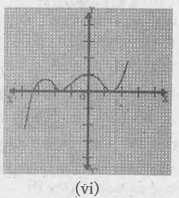కొన్ని p(x) బహుపదుల సంబందిత y=p(x) యొక్క పటాలు దిగువ ఇవ్వబడినవి. P(x) యొక్క శూన్యల సంఖ్యను పటాలు పరిశీలించి తెలపండి.

Step by step video & image solution for కొన్ని p(x) బహుపదుల సంబందిత y=p(x) యొక్క పటాలు దిగువ ఇవ్వబడినవి. P(x) యొక్క శూన్యల సంఖ్యను పటాలు పరిశీలించి తెలపండి. by Maths experts to help you in doubts & scoring excellent marks in Class 10 exams.
Updated on:21/07/2023Topper's Solved these Questions
- బహుపదులుBOOK - VGS PUBLICATION-BRILLIANT(TELUGU)CHAPTER - బహుపదులుEXERCISE - Exercise
245 Videos
- నిరూపక రేఖాగణితంBOOK - VGS PUBLICATION-BRILLIANT(TELUGU)CHAPTER - నిరూపక రేఖాగణితంEXERCISE - Exercise
175 Videos
- రెండు చరరాశులలో రఖభయ సమీకరణాల జతBOOK - VGS PUBLICATION-BRILLIANT(TELUGU)CHAPTER - రెండు చరరాశులలో రఖభయ సమీకరణాల జతEXERCISE - Exercise
197 Videos
Similar Questions
p(x)=5x7−6x5+7x−6అయిన కింది వానిని కనుగొనండి. x5 యొక్క గుణకం
View Solutionకింద ఇవ్వబడిన బిందువుల మధ్య దూరంను కనుగొనండి. (2,3) మరియు (4,1)
View Solutionగ్రాఫ్లు గీయకుండా,. a1a2,b1b2,c1c2 నిష్పత్తులు పోల్చి, కింద ఇచ్చిన రేఖాసమీకరణాల జతలు ఖందన రేఖలో, సమాంతర రేఖలో లేదా ఏకీభవించే రేఖలో కనుగొనుము. 5x−4y+8=0, 7x+6y−9=0
View SolutionName the enzymes 'P' and 'Q' that are involved in the processes given below.
ltimg src="https://d10lpgp6xz60nq.cloudfront.net/physics_images/BIO_044_SQP_XII_E01_005_Q01.png" width="80%"gt
View SolutionA light ray from an object 'P' is reflected from a mirror as shown in the figure, then
ltimg src="https://d10lpgp6xz60nq.cloudfront.net/physics_images/PS_PHY_VII_C04_E07_004_Q01.png" width="80%"gt
View SolutionDetermine the point of symmetry of a regular hexagon.
View SolutionMatch the following Column A to Column B

View SolutionMatch the following Column A to Column B

View SolutionMatch the following Column A to Column B

View SolutionThe inequation represented by the graph given below is :
View SolutionThe inequation that best describes the graph given below is _________
View SolutionThe inequation that best describes the following graph is _________
View SolutionIn Fig, find the value of x.
ltimg src="https://d10lpgp6xz60nq.cloudfront.net/physics_images/PS_MATH_IX_C12_S01_032_Q01.png" width="80%"gt
View SolutionAt x=0, value of (dy)/(dx) is : ltimg src="https://d10lpgp6xz60nq.cloudfront.net/physics_images/ALN_PHY_R04_E01_024_Q01.png" width="80%"gt
View SolutionAt point P, the value of (dy)/(dx) is : ltimg src="https://d10lpgp6xz60nq.cloudfront.net/physics_images/ALN_PHY_R04_E01_025_Q01.png" width="80%"gt
View SolutionIf y-x=180^(@) then find the values of x and y. ltimg src="https://d10lpgp6xz60nq.cloudfront.net/physics_images/ALN_PHY_R05_E01_034_Q01.png" width="80%"gt
View Solution
